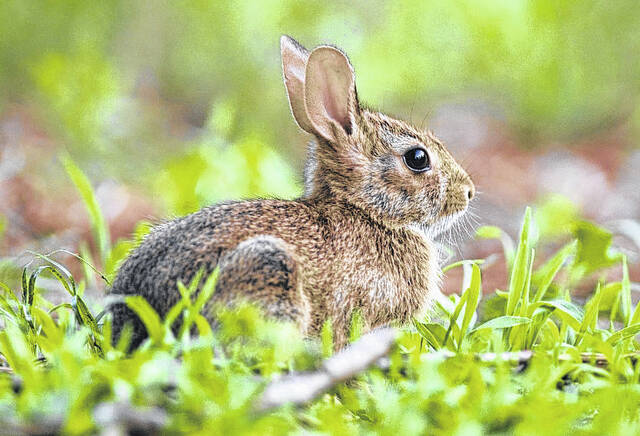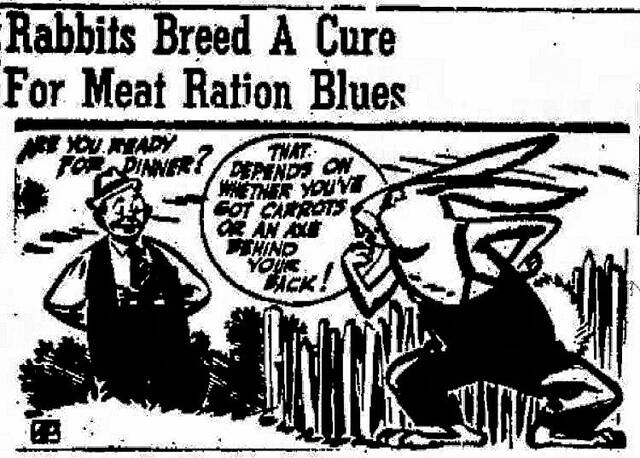
The rabbit is associated with Easter eggs. Two rabbit species inhabit Robeson County. Neither lays nor distributes eggs.
Courtesy photo | North Carolina Wildlife Resources Commission
LUMBERTON — Why an Easter bunny? Why is a rabbit associated with eggs? What is the rabbit really like?
According to the North Carolina Wildlife Resources Commission, Robeson County is home to a pair of rabbit species, the eastern cottontail and the marsh rabbit. Another species, the Appalachian cottontail, resides in the northwestern mountains. The eastern cottontail ranges across the state and can survive alongside humans in their backyards and in urban areas.
“Population densities are highest when there is suitable habitat at a sufficient scale, typically consisting of a patchwork of farmland and early successional habitat,” stated the NCWRC profile on the eastern cottontail rabbit.
The marsh rabbit, the NCWRC explained, has an altogether different lifestyle and disposition. The rabbit is partially aquatic and dwells in the swamp. Marsh rabbits are secretive and less frequently seen by people than the eastern cottontail. The eastern cottontail’s NCWRC species profile stated that the change from small farms to large-scale agriculture has created less favorable conditions for the rabbit and populations are likely to decline.
Rabbit hunting was popular in North Carolina in the first half of the twentieth century, peaking with more than 300,000 rabbits harvested in 1963, and steadily declining to less than 50,000 rabbits harvested in 2021. However, House Bill 93, An Act To Allowed Controlled Rabbit Hunting Preserve Operators To Purchase Live Box-Trapped Rabbits And Sell Rabbits To Other Licensed Operators, last revised on Feb. 14 and re-referred to the Committee on Rules, Calendar, and Operations of the House on April 5, suggests rabbit hunting hasn’t completely passed out of notability in North Carolina.
Real rabbits aren’t as wholesome and cuddly as the Easter bunny. According to the Encyclopedia Britannica, the herbivorous rabbit primarily derives nutrition from the difficult-to-digest cellulose in plants. Rabbits eat some of their food twice and have two forms of excrement, hard droppings and soft black viscous pellets which contain around quintuple the nutrients of the harder excrement, according to the Britannica article, the latter of which is eaten by the rabbit immediately following excretion, which the article explained allows rabbits to utilize the most nutrients from their food.
According to the Encyclopedia Britannica article on Easter liturgical observances the first recorded instance of painted eggs was in the thirteenth century. The eggs, the article explained, were painted because the medieval church did not permit their consumption during Easter, and something had to be done with the forbidden-to-eat eggs.
The first Easter egg hunt, continued the article, was conceived and organized by First Lady Lucy Hayes in 1878, the wife of President Rutherford B. Hayes, but as an egg roll on the White House lawn, a custom which was later abandoned. The Britannia article stated the rabbit is not the only animal associated with the delivery of eggs, adding that in Switzerland eggs are delivered by the cuckoo. In Australia, where rabbits are an invasive pest, the Foundation for a Rabbit-Free Australia Inc. have campaigned to replace the Easter bunny with an native and formerly endangered species, the Easter bilby.
In addition to the famous Easter bunny the rabbit has a strong and diverse presence in popular culture, from the famous parable of the tortoise and the hare, to mythological and figures in folk tales. Films featuring rabbits, Easter and non-Easter, include Night of the Lepus, a horror film featuring gigantic rabbits, the bizarre no-budget Santa Claus and the Ice Cream Bunny, and the animated fantasy Watership Down, adapted from Richard Adams’ novel of the same title.
Lumberton once had a Lumberton Rabbit Club, which had access to a smokehouse, and was mentioned in an article printed in the March 27, 1942 edition of The Robesonian. Judging from the article and other mentions of the organization, the club used beagles to hunt rabbits and stockpiled the rabbits over hunting season, holding 5o rabbits in the 1942 season, and celebrated with a rabbit dinner at the season’s conclusion. The club was founded by ‘Vall’ French, and is only mentioned in papers from 1942-43.
“Lumberton’s Rabbit Hunters club is right up to date,” declared a Dec. 9, 1942 article titled Praise the Lord and Pass the Rabbit, “Rabbits are coming back in style. The nationwide meat shortage is expected to produce a boom in backyard rabbit raising.”
A beneficiary of the Lumberton Rabbit Club mentioned in the articles was Bill Hartley, who was described as having unwell eyes which a certain W.W. Davis, who controlled the rabbit storage, would “prescribe” meals of rabbits with all the trimmings.
“Hartley seems to think he was benefitted by the rabbit prescription and here is hoping that Dr. Parker gives him and other one and that the writer will have opportunity to take another dose of medicine,” an article written by W.K. Bethune in the April 14, 1942 issue concluded, “Rabbit is fine.”
Copeland Jacobs can be reached at [email protected] or at 910-416-5165.







